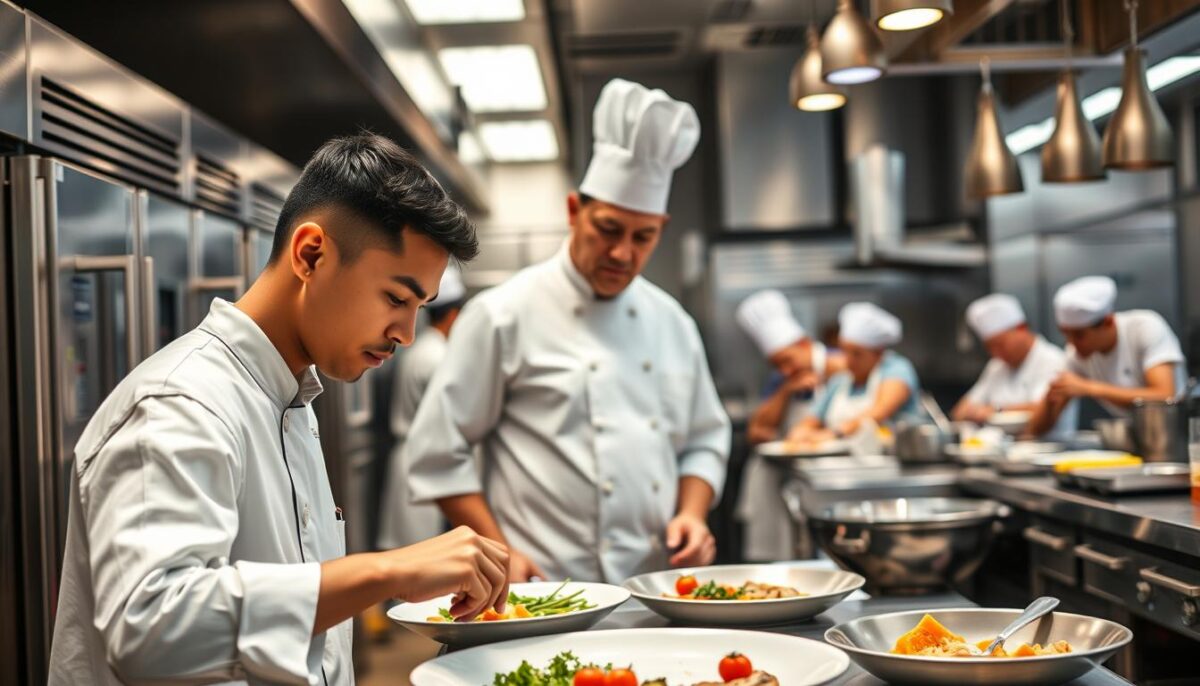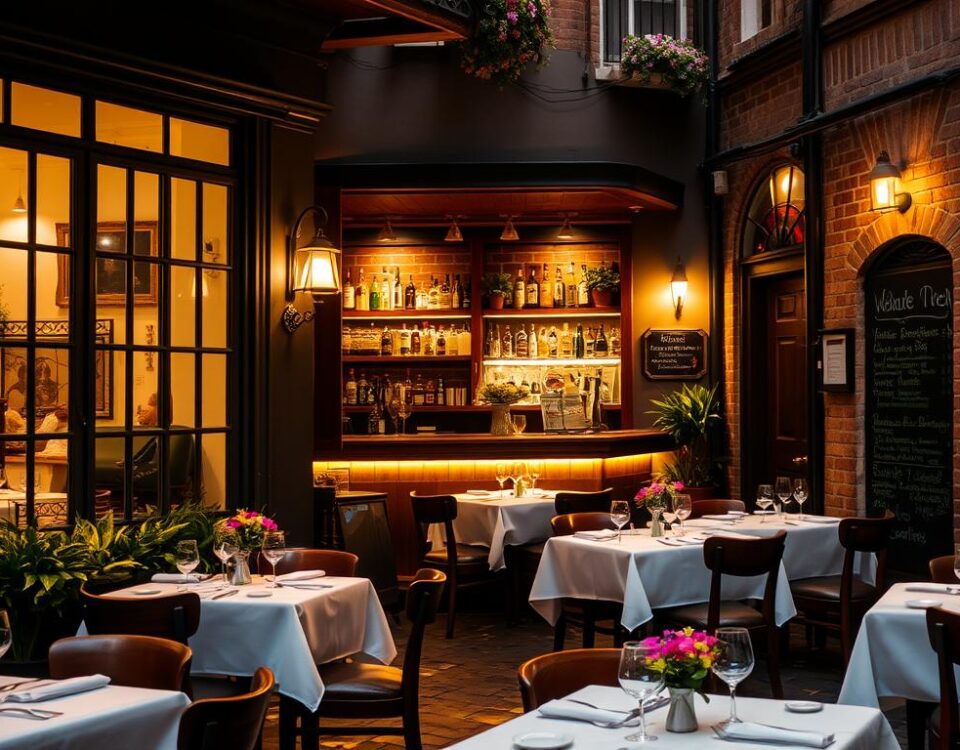
Executive Chef Salaries by State: Where Top Chefs Earn the Most in 2025
June 27, 2025
Top Chef Certification Courses to Boost Your Culinary Credibility
June 27, 2025I still remember the first time I helped my mom in the kitchen; the smell of freshly baked cookies and the sizzle of onions in a pan sparked a passion within me that has only grown stronger over the years. For many, the kitchen is more than just a place to cook – it’s a haven where creativity meets technique.
If you’re considering turning your passion into a career, you’re not alone; the culinary industry is witnessing a surge in interest, with a growing demand for skilled chefs. As you ponder the best path forward, you’re faced with a crucial decision: formal culinary education or hands-on apprenticeship.
Key Takeaways
- Understanding the differences between formal culinary education and hands-on apprenticeship is crucial for making an informed decision.
- Your personal learning style plays a significant role in determining which path is better suited for you.
- Financial considerations can significantly impact your choice between culinary school and apprenticeship.
- Both paths offer distinct advantages and challenges in the culinary industry.
- Career goals and aspirations should guide your decision-making process.
The Crossroads of Culinary Careers
Those who dream of a culinary career face a significant decision: whether to attend culinary school or embark on an apprenticeship. This choice is pivotal as it shapes their future in the culinary arts. The path chosen will influence not only their cooking skills but also their understanding of the culinary industry.
Culinary School Education
Culinary school represents a traditional educational route, offering a structured learning environment. Students gain foundational knowledge in various cuisines and techniques through classroom instruction and kitchen labs. This approach provides a comprehensive understanding of culinary arts.
Chef Apprenticeships
In contrast, chef apprenticeships offer a hands-on approach, immersing students in professional kitchen operations from day one. This “learn-while-you-earn” model allows aspiring chefs to develop skills while receiving a paycheck, differing significantly from the upfront investment required for culinary school.
| Aspect | Culinary School | Apprenticeship |
|---|---|---|
| Learning Environment | Classroom and kitchen labs | Professional kitchen |
| Financial Model | Upfront tuition | Learn-while-you-earn |
| Experience | Theoretical foundation | Hands-on experience |
Both paths aim to develop culinary professionals but take different approaches to training and skill development. Understanding these differences is crucial for aspiring chefs to make an informed decision about their career path.
Culinary School vs Apprenticeship: Breaking Down the Differences
Aspiring chefs often find themselves at a crossroads, deciding between the structured environment of culinary school and the practical experience of an apprenticeship. This decision is crucial as it impacts not only the learning experience but also future career prospects.
Learning Environment and Structure
Culinary schools offer a controlled classroom setting, providing a foundation in cooking techniques and kitchen management. In contrast, apprenticeships immerse individuals in real-world kitchen environments, where they learn from experienced chefs. The structured curriculum of culinary schools is complemented by the adaptive nature of apprenticeships, which adjust to the specific needs of the kitchen.
Time Commitment and Certification
Both paths require a significant time commitment. Culinary degree programs typically take 1-4 years, while apprenticeships last 1-3 years, often requiring a minimum of 1,000 hours of training. Upon completion, culinary school graduates receive a diploma or degree, whereas apprentices can earn industry-recognized certifications, such as those offered by the American Culinary Federation.
Financial Investment and Return
The financial aspects of these paths differ significantly. Culinary school requires a substantial upfront investment, often exceeding $30,000. In contrast, apprenticeships pay entry-level wages while individuals learn, allowing them to earn while gaining experience. This model helps apprentices avoid the student debt commonly associated with culinary school graduates.
| Criteria | Culinary School | Apprenticeship |
|---|---|---|
| Learning Environment | Controlled classroom | Real-world kitchen |
| Time to Completion | 1-4 years | 1-3 years |
| Certification | Diploma/Degree | Industry-recognized certification |
| Financial Investment | Substantial upfront cost | Earns while learning |

The Pros and Cons of Culinary School
For those considering a culinary career, understanding the advantages and disadvantages of formal culinary education is crucial. Culinary school can provide a comprehensive foundation, but it’s essential to weigh the benefits against the drawbacks.
Advantages of Formal Culinary Education
Formal culinary education offers several benefits, including exposure to diverse culinary techniques and cuisines. Students learn from various instructors, gaining a broad understanding of different cooking methods and international cuisines. This diversity is often hard to achieve in a single restaurant setting.
Diverse Culinary Techniques and Cuisines
Culinary schools expose students to a wide range of cooking techniques and cuisines, preparing them for various kitchen environments.
Business Knowledge and Career Advancement
Culinary schools often include business management courses, equipping students with the knowledge needed for eventual restaurant ownership or executive positions. This education goes beyond cooking skills, providing a solid foundation for career advancement.
Structured Learning Environment
The structured environment of culinary schools benefits students who thrive on systematic progression through techniques, with clear benchmarks and feedback from multiple instructors.
Disadvantages of Culinary School
Despite the advantages, there are significant drawbacks to consider. The high costs associated with culinary school can lead to substantial student debt, with some prestigious programs costing over $30,000 per year.
High Costs and Potential Debt
The financial investment required for culinary school is significant, and students must consider the potential for debt.
Classroom vs. Real Kitchen Experience
There’s a disconnect between classroom learning and real kitchen experience. School environments can’t fully replicate the pressure and pace of professional kitchens.
Culinary schools sometimes create unrealistic career expectations, with graduates expecting senior positions when entry-level work is the industry standard.
Ultimately, the decision to attend culinary school should be based on a careful consideration of these pros and cons, as well as an understanding of the American Culinary Federation’s role in recognizing quality programs.
The Apprenticeship Model: Learning While Earning
The apprenticeship model offers a unique ‘earn while you learn’ approach that’s been a cornerstone of culinary traditions worldwide. This method allows aspiring chefs to dive into real-world kitchen environments, developing practical skills and gaining experience under actual working conditions.

Benefits of the Apprenticeship Path
One of the primary advantages of culinary apprenticeships is the real-world kitchen experience they provide. Apprentices work alongside experienced chefs, learning the intricacies of kitchen operations and developing their skills through hands-on practice.
Real-World Kitchen Experience
Apprentices are immersed in the fast-paced environment of a professional kitchen, where they learn to work efficiently under pressure and develop their culinary techniques.
Professional Networking Opportunities
Working in a professional kitchen also provides valuable networking opportunities. Apprentices build relationships with experienced chefs and other industry professionals, potentially opening doors to future job opportunities.
Earning While Learning
A significant benefit of apprenticeships is the opportunity to earn a wage while training. This contrasts with the financial burden often associated with culinary school programs, where students typically graduate with significant debt.
Challenges of Culinary Apprenticeships
While apprenticeships offer many benefits, they also come with challenges. One potential drawback is the limited exposure to different techniques if an apprentice works under only one or two chefs.
Limited Exposure to Different Techniques
Apprentices may find their skills and knowledge are shaped by the specific practices of their mentor, which might not expose them to a wide range of culinary techniques.
Initial Low Wages
Many culinary apprenticeships start with low wages, which can make financial stability challenging in the short term.
Less Formal Business Training
Apprentices may receive less formal business training compared to culinary school students, potentially limiting their preparation for management or entrepreneurial roles.
Conclusion: Choosing Your Path to Culinary Success
Embarking on a culinary career requires a thoughtful decision between formal education and hands-on training. Both culinary school and apprenticeships can lead to successful chef careers when aligned with individual learning styles and goals.
Many successful chefs combine elements of both paths, perhaps starting with an apprenticeship and later supplementing with specialized courses. Gaining kitchen experience before committing to either path is crucial, as it helps understand the realities of the profession.
Certification from organizations like the American Culinary Federation can enhance a chef’s reputation and is valued by many employers. Ultimately, the “better” path depends on individual circumstances, including learning style, financial situation, and career goals. Passion, dedication, and continuous improvement are key to long-term success in the culinary industry.
FAQ
What is the main difference between a Culinary School and an Apprenticeship program?
The primary difference lies in the learning environment and structure. Culinary School provides a formal education setting, while an Apprenticeship offers hands-on training in a real kitchen environment.
How long does it take to complete a Chef Apprenticeship program?
The duration of a Chef Apprenticeship varies, typically lasting one to three years, depending on the program and the individual’s prior experience.
Are Culinary Apprenticeships paid?
Yes, most Culinary Apprenticeships are paid, allowing individuals to earn a wage while gaining practical experience in the kitchen.
What kind of certification can I expect from completing a Culinary Apprenticeship?
Upon completion, apprentices can receive certification from the American Culinary Federation, a recognized credential in the industry.
How do Culinary Schools and Apprenticeships compare in terms of cost?
Culinary Schools can be more expensive due to tuition fees, while Apprenticeships often provide a paid opportunity, reducing the financial burden on individuals.
Can I combine Culinary School education with an Apprenticeship?
Yes, some programs allow students to integrate formal education with practical experience, providing a comprehensive learning experience.
What are the job opportunities after completing a Culinary Apprenticeship or Culinary School?
Both paths can lead to various career opportunities in the kitchen, including roles in fine dining, restaurants, and hospitality management.
How do employers view Culinary Apprenticeships compared to Culinary School degrees?
Employers often value the practical experience gained through Culinary Apprenticeships, considering it a valuable asset in potential employees.



